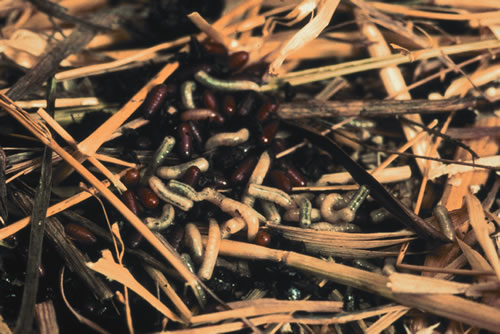
The problem with flies
Flies can be a significant problem in farming for a number of reasons:
• They affect farm productivity as they cause distress to production animals. In case of a heavy fly infestation this can result in reduced egg production and a drastic reduction in feed intake that has a negative impact on the animal's growth.
• They spread costly disease. Flies can transmit over 100 pathogens as well as viruses & bacteria. Amongst the diseases that can be transmitted are salmonellosis as well as avian influenza ("bird flu")
• Eventually, flies thereby reduce farm incomes through lower productivity and increased treatment cost. Globally, they cause production losses estimated to be in the billions of dollars.
• The Clean Neighbourhoods and Environment Act of 2005 gives local authorities the power to check business premises to investigate complaints of flies "being prejudicial to health or a nuisance" and issuing an abatement notice where premises fail to comply.
The fly – know thy enemy
A fly's sense organs are 10 million times more sensitive to sugar than the human tongue. Flies are attracted by contrast, colour, smell and sexual pheromones.
When they land, flies start to taste for food with their legs. Once they find something 'tasty' the proboscis is extended in a reflex action. The proboscis is pressed against the food and saliva is released to liquify any solids. These are then sucked up as a 'soup' via the fleshy mouth parts.
Up to 15 generations of flies could be produced in one year under typical UK climatic conditions with adult flies laying their eggs in warm, moist places such as manure and slurry. At any given time, only 15-20% of the fly problem is visible as the remaining 75-80% is present in the form of a "silent army" of larvae and pupae. There can be 7,000 maggots
in 1kg of dung.
Fly Control Basics
Effective fly control therefore is a combination of cultural, biological and chemical methods aimed at not only controlling adult flies but breaking the lifecycle early by preventing the earlier stages from developing into adult flies in the first place.
Cultural methods mean the monitoring of the fly population, the usage of physical barriers to prevent migration and external contamination as well as regular elimination of manure and other fly breeding sites.
Biological methods to encourage manure breeding fly predators such as beetles and wasps to survive, so they can reduce the fly population.
Chemical methods are usually necessary to achieve satisfactory levels of fly control, and include fly killing products that ideally will not kill biological fly predators. To be successful, an integrated approach should be adopted, killing both larvae and adult flies.
Larvicides are Insect Growth Regulators (IGR), preventing fly larvae from developing into adults, mostly by inhibiting the chitin synthesis. This creates a break in the fly lifecycle, preventing the proliferation of the fly population.
Adult insecticides (Adulticides) kill adult flies by contact or stomach poisoning via food. Nearly all act on the Central Nervous System (CNS) and most prevent signals crossing nerve synapses. Neuro-transmission is essential for vital functions and therefore when this gets interrupted, flies collapse and die. The alteration of different classes of adulticides is recommended to minimise the risk of resistance development.
Chemical Fly Control Program in Free Range Production
• As a free range producer, you ought to monitor each shed for fly and maggot activity. Free range egg production facilities can suffer from either house fly, muck fly or lesser house fly infestations and it is important to know which in order to fine tune your treatment regime accordingly.
• Keep manure as dry as possible by maintaining good ventilation, avoiding leaks from drinkers, leaking roofs, blocked gutters and water ingress.
• Eliminate feed spills, broken eggs and remove dead birds.
• Start fly control early in the season to avoid a heavy fly infestation in the first place.
• Apply a larvicide to stop the fly supply within breeding sites
• Simultaneously apply an adulticide either as a bait or as a paint / spray on to where flies rest & congregate
• Alternate adulticides and also look into options to control your red mite population
By using larvicides and adulticides in combination, and by implementing good hygiene practices, it is possible to significantly reduce the local population of flies to levels that remain below the threshold of economic threat.
Organic farmers are often struggling to find a suitable insecticide. It was only recently that the EU approved* the active ingredient Spinosad for use in "organic production of agricultural products".
* Commission Regulation No 404/2008.
